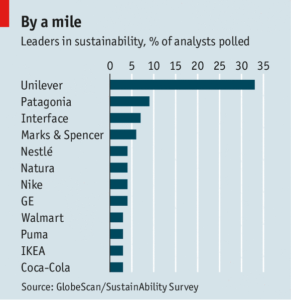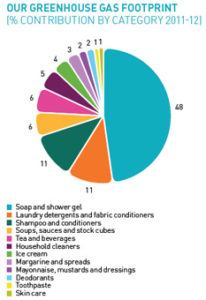UNILEVER: The Small Steps Necessary to Decrease a Large Footprint

How one of the world’s most respected consumer goods companies strives to answer the question: Is Sustainable Attainable?
THE PROBLEM: THE RISK CLIMATE CHANGE POSES TO UNILEVER
Unilever, the world’s second-largest consumer goods conglomerate that produces some of the world’s most iconic brands like Dove, Lipton and Hellman’s, appears to understand that climate change poses an enormous risk to its business. Climate change caused by the emission of greenhouse gases leads to water scarcity, extreme weather such as tsunamis and earthquakes, decreases in productivity across the agricultural supply chain, and increased food and material costs, all of which directly affect Unilever’s business as a manufacturer of food and consumer products. Unilever has already estimated that natural disasters linked to climate change cost the company $300M a year, or 6% of its net profits [1].
If greenhouse gas emissions continue at current levels, experts predict that profits of the consumer goods industry could be destroyed in 30 years. Consequently, Unilever is taking steps to combat this global crisis [2].
THE SOLUTION: THE SUSTAINABLE LIVING PLAN
In 2010, Unilever set an ambitious goal as a part of its Sustainable Living Plan: cut the company’s environmental footprint in half by 2030. Unilever recognizes that this will be an uphill battle, but believes it will be possible through the reduction of its greenhouse gases, water usage, and waste, and by sourcing agricultural materials sustainably [3].
The four pillars of Unilever’s sustainability plan are:
- Create growth opportunities
- Lower costs
- Eliminate risk (e.g. by ensuring long-term access to raw materials)
- Create trust with consumers and employees. [4]
To hold management accountable and emphasize the importance of sustainability, Unilever has taken steps to tie executive pay to certain sustainability targets. This bold action caused many climate experts to perceive Unilever as one of the industry leaders fighting climate change, which is evidenced by a study concluding that over 30% of industry experts chose Unilever as a leader in sustainability [5].
Deforestation and Sourcing
Deforestation – the clearance of trees to transform forests into cleared land – results in increased carbon emissions, thereby contributing to the acceleration of climate change. Unsurprisingly, commercial agriculture has been the cause of 71% of tropical deforestation in the last 12 years. Despite being one of the largest purveyors of commercial agricultural products, Unilever is committed to combatting deforestation and has pledged to sustainably source 100% of its raw materials by 2020 [6]. To this end, Unilever is working to ensure it can trace the sources of its products that have the potential to originate from deforested regions. For example, Unilever’s sourcing of palm oil – a product used to produce many Unilever products, such as Dove soap and TRESemmé shampoo – was previously supplied from deforested plantations in Asia; however, through this new initiative Unilever switched to sustainable palm oil suppliers. Unilever’s efforts to be aware of its suppliers’ practices and to ensure that materials are traceable and certified have caused the company to cut down on its number of suppliers [7].
Environmentally-Friendlier Products & Packaging
Unilever is also focusing on the environmental footprint of its packaging and products by investing in product innovations to help reduce its environmental impact. For example, Unilever has worked to decrease the amount of resources used in some of its newer and most popular items. When launching their Sunsilk shampoo line in Latin America, Unilever saved 2,300 tons of plastic per year by reducing the variety of cap and bottle sizes. This reduction led to 300 fewer trucks on the road each year, decreasing greenhouses gases caused by emissions. Unilever has also worked to remove phosphates from its detergents given that phosphates produce higher carbon emissions than alternative substitute ingredients. Unilever has already seen results from its efforts, and has reduced CO2 emissions by 39% per ton of production between 2008 and 2015 [4].
WHAT’S NEXT?
While Unilever is moving in the right direction, Unilever has not yet proven to be on track to meet its goals. Although Unilever has implemented its sustainable living plan, taken steps to prevent the sourcing of products from deforested areas and switched to more environmentally-friendly packaging and products, the greenhouse gases Unilever produces have gone up by 6% since the launch of these initiatives. Deadlines have also been an obstacle, as the company has already pushed back the goal of halving its production from 2020 to 2030 [8].
As a next step, Unilever must change consumers’ ways of thinking about sustainability. The company must emphasize that the responsibility is not just theirs; rather, working towards sustainability is a partnership between the company, its customers, and its suppliers. Furthermore, they must educate consumers via their marketing that when small changes are compounded, it can lead to significant results. With a Unilever product being used 2 billion times a day, Unilever needs to demonstrate that small everyday actions can save money for both the company and the customer, while helping to save the world as well [9]. (795 words)
[1] Unilever, “What is Climate Change?” https://brightfuture.unilever.com/stories/473087/What-is-climate-change–How-can-we-take-action-.aspx, accessed October 2016.
[2] Polman, Paul, “Unilever’s CEO on Making Responsible Business Work,” Harvard Business Review, https://hbr.org/2012/05/unilevers-ceo-on-making-respon, accessed November 2016.
[3] Unilever, “Sustainable Living,” https://www.unilever.com/sustainable-living/the-sustainable-living-plan/reducing-environmental-impact/, accessed October 2016.
[4] Unilever, “Collective Action Summary of Progress,” https://www.unilever.com/Images/uslp-mobilising-collective-action-summary-of-progress-2015_tcm244-424809_en.pdf, accessed October 2016.
[5] “In Search of Good Business,” The Economist, August 9, 2014, http://www.economist.com/news/business/21611103-second-time-its-120-year-history-unilever-trying-redefine-what-it-means-be, accessed November 2016.
[6] Catanoso, Justin, “Unilever CEO: We Need to do More to Fight Climate Change,” Business Insider, December 8, 2014, http://www.businessinsider.com/unilever-ceo-speaks-on-climate-change-2014-12, accessed November 2016.
[7] Evans, Peter, “Unilever Commits to Sustainable Palm Oil by End of 2014,” The Wall Street Journal, November 12, 2013, http://www.wsj.com/articles/SB10001424052702304644104579193841716811338, accessed October 2016.
[8] Skapinker, M., & Daneshkhu, S. (2016). “Can Unilever’s Paul Polman Change the Way we do Business?” FT.Com, Retrieved from http://search.proquest.com.ezp-prod1.hul.harvard.edu/docview/1833392448?accountid=11311
[9] Trebilcock, B 2015, ‘How They Did it: Unilever’s Journey to “Zero Waste to the Landfill”‘, Supply Chain Management Review, 19, 6, pp. 34-41, Business Source Complete, EBSCOhost, viewed 3 November 2016.







I am really impressed with all of the sourcing and design changes that Unilever is making. It is awesome that they have found a way to save money and help the environment. They are a great example that these two things can go hand in hand. One other thing they could look at (and they probably already have) is looking at using recycled plastic for the shampoo and shower gel bottles. Perhaps they could change consumer behavior by encouraging or incentivizing the recycling of their containers.
Erica – I really enjoyed reading your article, great job in summarizing what Unilever is doing. I am so impressed to hear how much effort they are putting into being sustainable – from sourcing their palm oil to designing their products.
The fact that Unilever has had a history of designing products that use much less water as a whole including things like Lux (a body wash designed to use up to 11% less water since you do not need water for lathering – https://www.unilever.com/sustainable-living/the-sustainable-living-plan/reducing-environmental-impact/water-use/helping-consumers-maximise-water/ ) and Surf Excel Quickwash (a laundry detergent Unilever created in India for hand washing which uses less water because of the fast foaming action – https://www.unileverme.com/about/innovation/product-innovations/clean-clothes-less-water/ ) is something I hope other companies take note of. While both of these products are important for their environmental impacts, they also make business sense for Unilever since it is extremely difficult to get water in India and therefore their products are more marketable. I sincerely hope other companies will follow Unilever’s lead.
Great insight into Unilever’s efforts to combat climate change. I wonder why Unilever had such an issue meeting its (lofty) targets. I would imagine their initiatives were part marketing (i.e., appealing to climate change enthusiast consumers and limiting reputational risk) and part genuine business need (i.e., reducing costs). At the end of the day, implementing serious changes to your business to become more sustainable are extremely difficult: (a) internal buy-in is needed by individuals who are skeptical about shifting from the status quo, (b) performing proper due diligence on all parts of your supply chain and building relationships with new, sustainable suppliers is incredibly onerous and imperfect, and (c) change in manufacturing processes, equipment, and materials is expensive. While Unilever is making a valiant effort – one that looks good for the environment, looks good to the consumers, and looks good to the market – expectations should be tempered until they have a real understanding of what all of the crucial aspects of changing the business to be sustainable are.
I remember being very inspired by Unilever’s commitment to innovating to both improve sustainability as well as continue to meet their customer promise to deliver household products that we know and love. Lindsey touched upon one of my favourite examples – tailoring their laundry product in India to both better cater to hand-washing as well as to save water. Another example I learned of during my R&D summer internship is the development of concentrated liquid laundry detergent. Making the liquid detergent more concentrated (2x at the time) benefited the consumer (taking up less storage space in the home, a container for the same number of washes was less heavy) as well as the environment (significant reduction in packaging, raw materials, and therefore carbon footprint of the product). In this case it is in fact consumer behaviour that serves as the biggest barrier in realising the full environmental benefit of the product. Many consumers struggle to believe that such a small quantity of detergent would have the same cleaning power as a larger volume used historically. Consumer product companies, like Unilever, have attempted to combat this perception by intentionally increasing viscosity of the product (to signal increased concentration), ensuring that the dosing is clearly marked on their packaging, or providing pre-packaged dosing (e.g., laundry tablets). It is interesting to see the indirect role CPG companies can play in influencing consumer behaviour towards more sustainable products!
Great article, Erica! Thank you. Unilever is renowned for their efforts to create sustainable products, but it is impressive to see their wide ranging and impactful efforts, engaging and incentivising employees, customers and suppliers alike. Paul Polman, has used his position as Unilever CEO to tirelessly encourage govenrments to take responsibility for climate change, with arguments anchored in science and economic logic. It is hard to ignore the head of a EUR 53billion consumer goods company who states, “There was a belief among some politicians that the main challenge is job creation and economic growth, and if we get side-tracked with climate we might not achieve the economic growth.
The reality is, if we don’t tackle climate change we won’t achieve economic growth.”